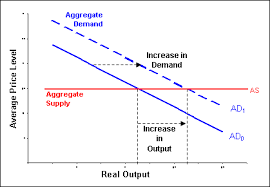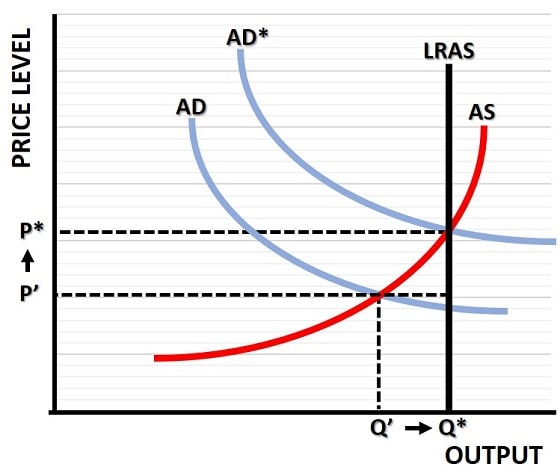Module 6: Short Run Aggregate Supply with LRAS & AD
1/43
There's no tags or description
Looks like no tags are added yet.
Name | Mastery | Learn | Test | Matching | Spaced |
|---|
No study sessions yet.
44 Terms
When did the classical model work well?
To explain economic recessions before the Great Depression
What is the classical model also called?
The AD/LRAS Model
What were past recessions based on?
Supply disruptions with items from sPENT decreasing
What happens when items from sPENT decrease?
Prices rise
GDP falls
Unemployment rises
What is the Keynesian Model used for?
The short-run
What are the Key Assumptions of the Keynesian model?
Sticky or rigid prices/wages
What are the sources of price rigidities (sticky)?
Union and other long-term contracts
Menu costs
Slow to adjust
What is the opposite of sticky prices?
Rigid prices
Capitalism may not be WHAT?
Self-regulating
What does the Keynesian model look like?

What are the characteristics of the classical model of economics?
Flexible prices
Long run view
LRAS determines output
What are the characteristics of the keynesian model of economics?
Rigid (stuck) prices
Short run view
AD determines output (GDP)
What does the impact of a change in AD depend on?
The shape of the SRAS
What does the level of price flexibility determine?
The SRAS shape
Why do prices rise in the long run?
The economy can only create goods and services based on the keys to long run growth
If there is more demand for goods and services, what do firms eventually do?
Raise prices because they cannot sustainably continue to create more based on the level of sPENT
What does the AD-AS model look like?

What happens in the short run of the AD-AS if aggregate demand falls?
Prices decrease and real GDP decreases
In the long run, where is the economy?
At the intersection of LRAS and AD
In the short run, where is the economy?
At the intersection of SRAS and AD
What causes both aggregate supply curves to shift right?
Discoveries of new raw materials (N incr.)
Increased competition (P incr.)
A reduction in international trade barriers (P incr.)
Fewer regulatory impediments to business (P incr.)
An increase in labor supplied (N incr.)
Increased training and education (E incr.)
A decrease in marginal tax (N incr.)
What happens if sPENT increases?
LRAS and SRAS shift right
Are magnitudes of shift important?
Yes
What causes the short run aggregate supply curve to shift left?
Increased inflationary expectations
Increase in input prices
What are input prices?
Energy (oil, gas, etc.)
Raw Materials (steel, lumber, etc.)
Wages
What happens if supply shifts?
price and real GDP move in opposite directions
What happens if demand shifts?
price and real GDP move in the same direction
What is an Aggregate Demand Shock?
Any shock that causes the aggregate demand curve to shift inward or outward
What is an Aggregate Supply Shock?
Any shock that causes the aggregate supply curve to shift inward or outward (supply chain issues)
What is a recessionary gap?
GDP < LRAS
Actual GDP < Potential GDP
How do you see if recessionary gap is getting bigger?
Potential GDP - Actual GDP
What does a growing recessionary gap mean?
Growing unemployment rate
What does it mean if short run equilibrium is to the left of long-run equilibrium?
Recessionary gap
What is an inflationary gap?
GDP > LRAS
Actual GDP > Potential GDP
How do you see if an inflationary gap is getting bigger?
Actual GDP - Potential GDP
Can you have a recessionary gap with inflation/deflation (and vice versa)?
Yes
What are the economic corrections for a recessionary gap?
Inflation expectations and/or input prices fall
SRAS shifts right
Prices fall more but GDP increases
What are the economic corrections for an inflationary gap?
Inflation expectations and/or input prices rise
SRAS shifts left
Prices rise and GDP falls back to potential
What does economic correction mean?
Without intervention
How can the simple model be misleading?
No long-run growth (real potential GDP)
Deflation in model is too common
What are the new assumptions for the complex aggregate demand and aggregate supply model?
Potential Real GDP increases
AD increases
SRAS increases
Why do LRAS and SRAS rise?
Due to increases in sPENT
Why does AD rise?
Due to increases in income, business spending, public goods, international growth, money
What can the dynamic model illustrate?
Real world outcomes